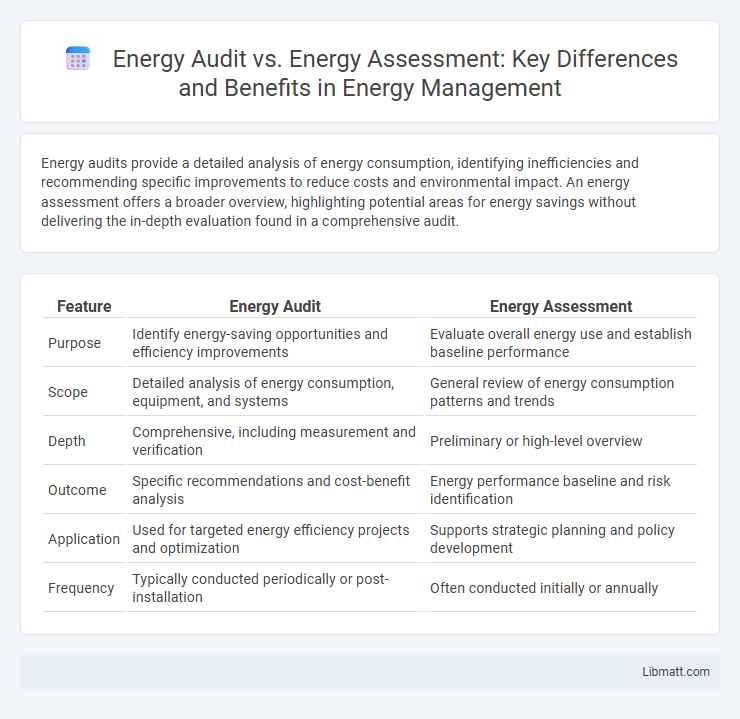Energy audits provide a detailed analysis of energy consumption, identifying inefficiencies and recommending specific improvements to reduce costs and environmental impact. An energy assessment offers a broader overview, highlighting potential areas for energy savings without delivering the in-depth evaluation found in a comprehensive audit.
Table of Comparison
| Feature | Energy Audit | Energy Assessment |
|---|---|---|
| Purpose | Identify energy-saving opportunities and efficiency improvements | Evaluate overall energy use and establish baseline performance |
| Scope | Detailed analysis of energy consumption, equipment, and systems | General review of energy consumption patterns and trends |
| Depth | Comprehensive, including measurement and verification | Preliminary or high-level overview |
| Outcome | Specific recommendations and cost-benefit analysis | Energy performance baseline and risk identification |
| Application | Used for targeted energy efficiency projects and optimization | Supports strategic planning and policy development |
| Frequency | Typically conducted periodically or post-installation | Often conducted initially or annually |
Introduction to Energy Audit and Energy Assessment
An Energy Audit systematically evaluates a building's energy consumption to identify inefficiencies and recommend cost-effective improvements, using detailed data collection and analysis. An Energy Assessment provides a broader overview of energy use, often serving as a preliminary evaluation to determine the scope and priority of energy-saving opportunities. Both processes aim to optimize energy performance but differ in depth, with audits offering granular insights and assessments focusing on general energy trends.
Defining Energy Audit: Scope and Purpose
An Energy Audit is a detailed, systematic evaluation of a building or facility's energy consumption to identify specific energy-saving opportunities and inefficiencies. It involves on-site inspections, data collection, and analysis of energy use patterns, equipment performance, and operational practices to develop actionable recommendations for reducing energy costs. The primary purpose of an Energy Audit is to provide a comprehensive roadmap for optimizing energy efficiency and achieving measurable financial and environmental benefits.
What is an Energy Assessment? Key Features
An Energy Assessment is a detailed evaluation of a building's energy consumption patterns aimed at identifying energy-saving opportunities and improving efficiency. Key features include analysis of HVAC systems, lighting, insulation, and equipment performance, often using real-time data and energy modeling software. This process helps prioritize cost-effective measures for reducing energy usage and operational expenses.
Core Differences: Energy Audit vs Energy Assessment
Energy audit involves a detailed analysis of energy consumption in buildings or processes to identify specific areas for energy savings and efficiency improvements, often including precise measurements and financial analysis. Energy assessment provides a broader overview of energy use patterns and potential conservation measures without the detailed data collection characteristic of audits. Your choice depends on whether you need comprehensive, data-driven insights (energy audit) or a general evaluation of energy performance (energy assessment).
Types of Energy Audits Explained
Energy audits come in three main types: preliminary, detailed, and investment-grade audits, each varying in scope and accuracy. A preliminary audit offers a quick overview of your facility's energy use and identifies obvious savings opportunities, while a detailed audit provides comprehensive analysis, including equipment-level consumption and cost-saving recommendations. Investment-grade audits delve deeper with rigorous data collection and financial analysis, suitable for large projects requiring precise budgeting and feasibility studies.
When to Choose an Energy Assessment
An Energy Assessment is ideal when you need a comprehensive evaluation of your building's overall energy performance to identify major areas of improvement and long-term savings potential. You should choose an Energy Assessment if your goal is to understand how your facility uses energy across systems and pinpoint strategic upgrades or behavioral changes. This approach provides detailed data and recommendations tailored to maximize energy efficiency in your property.
Benefits of Conducting an Energy Audit
Conducting an energy audit provides a detailed analysis of your building's energy consumption, identifying inefficiencies and opportunities for cost savings. It highlights specific areas where energy use can be reduced, leading to lower utility bills and improved environmental impact. By understanding your energy profile through an audit, you can make informed decisions that enhance operational efficiency and support sustainability goals.
Cost and Time Considerations
Energy audits typically require more extensive data collection and analysis, leading to higher costs and longer timeframes compared to energy assessments. Energy assessments offer a quicker, lower-cost overview of energy use, identifying immediate savings opportunities without the detailed quantification that energy audits provide. Businesses with limited budgets or time constraints often choose energy assessments, while more comprehensive audits serve organizations aiming for in-depth energy optimization and long-term savings.
Case Studies: Real-world Applications
Case studies highlight the nuanced differences between energy audits and energy assessments through real-world applications, demonstrating how audits provide detailed energy consumption data and actionable recommendations for efficiency improvements. Energy assessments often precede audits, offering broader evaluations of potential energy-saving opportunities across facilities or systems. Your organization can benefit from understanding these examples to tailor energy strategies that optimize performance and reduce costs effectively.
Choosing the Right Approach for Your Facility
Selecting the appropriate approach between an energy audit and an energy assessment depends on the specific needs and scale of your facility. Energy audits provide detailed analysis of energy consumption and identify cost-saving opportunities, ideal for facilities seeking comprehensive insights and actionable recommendations. Energy assessments offer a broader overview, suitable for smaller facilities or initial evaluations to prioritize energy efficiency measures before committing to extensive audits.
Energy Audit vs Energy Assessment Infographic

 libmatt.com
libmatt.com